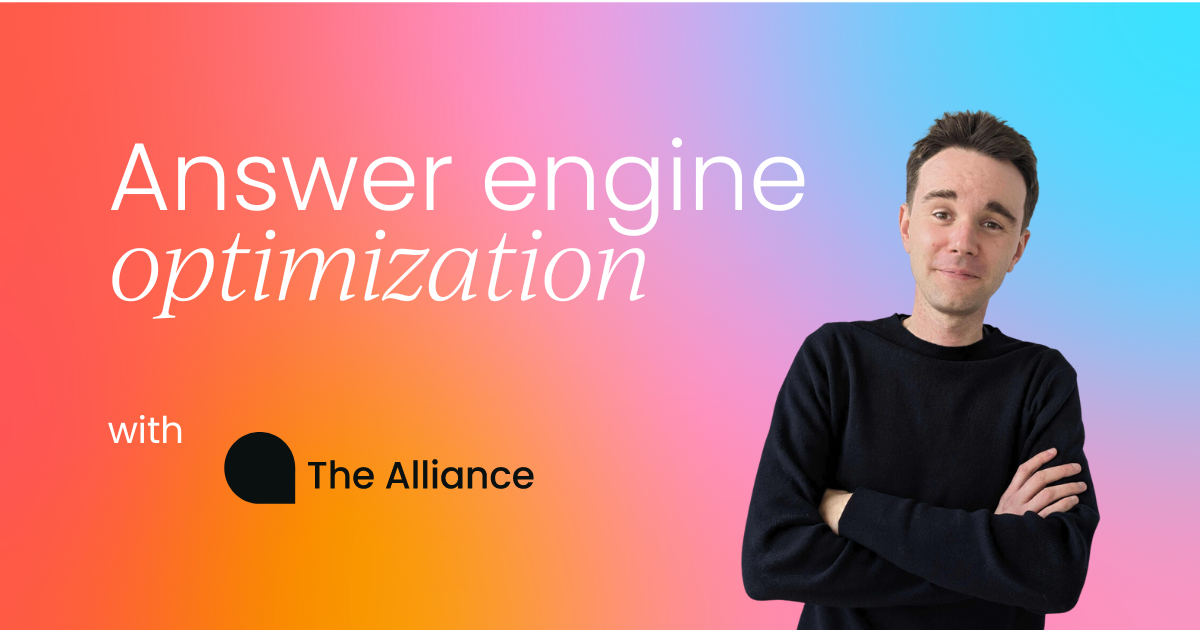From the moment ChatGPT was released to the public, one thing became clear: Search, as we knew it, was about to change.
The ability of OpenAI’s chatbot to provide near-instant answers to specific, complex questions quickly made traditional search engines appear antiquated. And the record-breaking popularity of ChatGPT proves beyond doubt that there’s a widespread appetite for this new way of discovering information online.
Alphabet and Microsoft, the dominant players in search, have taken notice. In response, they’ve reimagined their core search products, choosing to move beyond the familiar “10 blue links” model by incorporating generative AI into their organic results.
The latest, and most consequential, milestone on this journey is Google’s unveiling of its Search Generative Experience (SGE), an experimental approach to search which seeks to leverage generative AI to help users resolve their queries within Google’s ecosystem.
SGE might represent a radical rethinking of search, but it’s actually part of a broader, longstanding aspiration to transform search engines into answer engines.
We’ve seen glimpses of this through featured snippets, and other rich results, but SGE promises to do a far better job of allowing users to do more with a single search – and find the answers they’re looking for without leaving the platform.
In this article, we'll be discussing what we've been doing at The Alliance to tackle this issue, including how to:
- Optimize for conversational search
- Create content that can't be replicated
- Establish deep topical authority

Is SEO really dead this time?
SEO is often pronounced “dead”, but reports of its demise have always been greatly exaggerated. SGE, though, presents a different kind of challenge, and its ongoing rollout has understandably sent a wave of existential panic through the publishing world.
At the heart of Google’s new approach to search is the “AI snapshot”. This AI-generated snippet is part of Google’s attempt to resolve more long-tail queries within its own ecosystem, something that has the potential to dramatically reduce clicks to third-party websites.
If executed well, AI snapshots could lead to an enormous increase in the number of “zero-click searches” – the enemy of online publishers. It’s commonly thought that if the introduction of featured snippets served to weaken click-through rates, then we can expect AI snapshots to vaporize them.
The above assessment might be bleak, but the consequences of Google’s rethinking of search will undoubtedly be far-reaching. Whichever way you slice it, publishers and retailers can expect to start receiving lower volumes of traffic in the coming months. That much appears unavoidable.
So where does this leave us? Do we throw in the towel and give up on organic search entirely?
Not so fast.
While SGE promises to be hugely disruptive, it will produce winners. After all, SEO has always been a moving target, and publishers will need to adapt once again to the ever-changing landscape of search.
At The Alliance, we’ve been preparing for the new era of organic search (SEO 2.0) since the release of Bing Chat earlier this year. Our strategy is built on three key focus areas, each of which is geared towards ensuring that our websites remain visible in AI-powered search engines.

Read on for a breakdown of the approaches we’re taking.
Optimizing for conversational search
The most significant innovation in SGE is “conversational mode”. This is where users can enter into a ChatGPT-style conversation away from the search engine results page (SERP).
Here, searchers will have the opportunity to ask follow-up questions or select from suggested prompts, explore the topic in more depth, or branch out into related subject areas.
Conversational search opens up endless possibilities. Searchers will be able to enter highly personalized and specific queries – and receive tailored responses that match user intent with a level of accuracy previously not possible. This will mark the beginning of a new era of “natural language search”.
The prospect of personalized conversational search should be a wake-up call for creators and publishers. If we want our content to feature (and receive citations) in conversational mode, we must move beyond simply optimizing for short-tail and generic long-tail queries.
Our job is instead to predict the types of follow-up questions that are likely to take place beneath short-tail queries. I use the word “predict” deliberately because privacy considerations mean it’s unlikely we’ll ever know what actually takes place within conversational mode.
One way to make these predictions is to engage in conversations ourselves. At The Alliance, we’re using platforms like Perplexity to have extensive conversations with LLMs to generate banks of potential “follow-up” queries that relate to the high-volume keywords we typically target.
As we pursue these conversations, we keep a record of all the follow-up prompts that Perplexity’s AI suggests. This process helps us to understand the types of ultra-specific, natural language queries that are likely to come up within Google’s conversational mode in SGE. It’s not an exact science, but it helps us uncover new queries that we can potentially target.
The final step is to create new pages (or optimize existing high-traffic pages) to target these more niche queries. In a sense, it’s no different from optimizing pages for People Also Asked queries. The difference, though, is in how we discover these opportunities.
Traditional SEO tools won’t be able to guide us (at least not yet). Instead, we'll have to put ourselves in the shoes of our target audiences and engage in AI search conversations ourselves. Only then will we start to discover the myriad keyword possibilities engendered by conversational search.
Experience and opinion: creating content that cannot be replicated
Prior to the introduction of rich results, a user would have to navigate to third-party websites to find out last night’s baseball scores, today’s weather, or the time in, say, London or Sydney.
Rich results have, of course, turned these queries into zero-click searches – and the websites that once relied on them for traffic have been forced to turn to other methods.
SGE promises to multiply the number of zero-click queries. If the AI Snapshot becomes a trusted source for searchers (which, admittedly, is still a big ‘if’), then a whole host of “what is” and “how to” queries will cease to be reliable sources of quality traffic.
But it’s important to remember that informational search isn’t just about getting the facts. Searchers are instead often seeking advice and guidance in the form of unique perspectives, opinions, and first-hand accounts.
Google knows this, and it’s gone to great lengths to encourage creators to showcase their experience – even going so far as to add an additional E to its E-A-T credo.
One thing we can be sure of is that SEO strategies that rely on answering basic questions and offering the “facts”, will be quickly rendered obsolete in a world where AI snapshots can handle basic informational search.
In the new era of search, creators will need to offer something that AI cannot, namely real-world experience and informed opinion. This means going far beyond providing mere explanations and instead drawing on unique experiences that offer helpful advice.
This is great news for subject matter experts (SMEs) who draw on personal experiences in their content. We expect this is precisely the kind of content Google will seek to include in AI snapshot recommendations and conversational mode citations.
Google isn’t naive about the limitations of generative AI, and human content, grounded in real-world experience, will be vital for informational corroboration.
There are a number of techniques creators can adopt to demonstrate authentic experience. These range from using simple textual signals, like the use of first-person pronouns, to leveraging proprietary data to form unique insights. Case studies, interviews, and expert-authored op-eds will also be vital content mediums to adopt in the new era of search.
If your content is created by professional copywriters (rather than SMEs), it'll be harder to demonstrate expertise and experience – but it’s not impossible. If you haven’t already, now is the time to build up a roster of expert contributors who you can call on for quotes, stories, case studies, and interviews.
The key is to ensure that you’re providing informed perspectives, from trusted sources, that cannot be replicated by chatbots, which are capable only of proving the facts.
Establishing deep topical authority
At the time of writing, we have very little idea about how Google selects pages to appear within its AI Snapshots. Ranking in the top 3 in the traditional results doesn’t mean your page will be referenced in the Snapshot. Remember, SGE is about delivering personalized search experiences.
Provided SGE is good at resolving complex, natural language long-tail queries, we can assume that searches will start asking more of them. This will multiply the number of potential queries to target, in turn increasing the demand for relevant content that can be used for corroboration.
Far from putting content writers out of business, SGE could give forward-thinking businesses a reason to increase their supply of quality content. In practice, this will mean building deeper topic clusters, covering a wider range of queries, and addressing narrower, more specific audiences.
Suppose, for instance, you run a website focused on helping businesses manage their analytics. Instead of creating a guide on how to set up GA4, we would recommend writing multiple guides on GA4, each targeting a specific industry or sector – for instance, “GA4 for e-commerce websites” and “GA4 for publishers”.

When creating content, it'll be increasingly important to thoroughly cover all aspects of a given topic, and update it regularly to maintain relevance and freshness. Additionally, using semantic keywords — variations and synonyms of your main keyword — will help search engines understand the breadth and depth of your content.
This isn’t just about matching search intent for a greater number of keywords (although that’s part of it). Instead, it’s about demonstrating authority by offering deep, reliable, and extensive information on their specific subject matter.
The future of search, TL;DR
To navigate the future of search (SEO 2.0), we recommend focusing on three key areas.
First, optimizing for conversational search is essential. The introduction of this new mode allows users to engage in ChatGPT-style conversations, leading to personalized and specific queries.
To be featured in conversational mode, creators must go beyond optimizing for generic queries and must instead predict the likely follow-up questions users might have. Platforms like Perplexity can be utilized to generate potential follow-up queries and uncover new keyword opportunities that align with conversational search.
Second, creating content that cannot be replicated by AI snapshots is going to be vital for remaining visible in the SERPs. While AI snapshots may handle basic informational searches, they lack the ability to provide real-world experience, opinions, and unique perspectives.
By offering helpful advice, drawing on personal experiences, and providing informed opinions, creators can demonstrate their expertise and stand out in the new era of search.
Lastly, SGE's emphasis on delivering personalized search experiences means there will be an increase in complex, natural language long-tail queries. This presents an opportunity for businesses and publishers to increase their supply of quality content.
By building deeper topic clusters, addressing narrower audiences, and thoroughly covering all aspects of a given topic, creators can demonstrate authority and relevance in their content.
While the future of search may seem uncertain, adapting to SEO 2.0 requires embracing the potential of conversational search, offering unique and valuable content, and establishing deep topical authority.
By staying ahead of the curve and aligning strategies with the changing search landscape, creators and publishers can continue to thrive and reach their target audiences in the ever-evolving world of search.



 Follow us on LinkedIn
Follow us on LinkedIn




